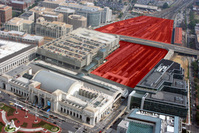Added height with design review proposed for Union Station railyards, Lower Barracks Row
Two zoning proposals, one for the Union Station railyards and one for Lower Barracks Row near the Navy Yard, provide opportunities to allow some development and ensure good urbanism in any projects.
On Thursday, the Zoning Commission will review proposed zoning for the railyards north of Union Station, on either side of the H Street “Hopscotch” bridge.
The Office of Planning proposes allowing buildings up to 130 feet in height, as measured from the H Street overpass. 130 feet is the maximum allowed by the Height Act, but there is debate about where to count zero. If the building fronts a bridge, is the “bottom” of the building at the level of the bridge, or at the level of the ground below?
For the zoning rewrite, OP recommended counting from the ground, not a bridge. But applying that rule for the railyards means that a significant amount of the otherwise allowable building envelope will be taken up by the yards, making it much less financially feasible to build the platform.
Also, with only low building heights, there will be a strong incentive to create boxy buildings that fill up as much of the envelope as possible, whereas with 130 feet of height, it’ll be possible to build more aesthetically pleasing buildings. And the site is limited to 6.5 FAR, meaning 130-foot boxes would simply not be allowed.
If approved by the Zoning Commission, this height won’t come without strings. Akridge, the developer for the project, will have to submit all buildings to design review including two phases of community review, approval by the Zoning Commission, and approval by the Historic Preservation Review Board. In other words, they won’t have the right to build just any buildings, but have to build nice buildings.
Meanwhile, residents and businesses are proposing increasing building heights around 8th Street between the Southeast Freeway and the Navy Yard to 65 and 85 feet, which is still not very high.
As Lydia DePillis explains, that area was limited to 45 feet in 1999 to preserve historic buildings, but it’s ultimately led to both historic and nonhistoric buildings sitting moribund. Instead, the proposal would increase the height but also require structures over 45 feet to go through design review with community involvement, preservation of historic structures, and a quality plan.
Both proposals follow the principles from Larry Beasley’s speech on the height limit to avoid the mistakes of the NoMA upzoning. Simply allowing extra height just gives property owners a one-time windfall that ironically can tie the hands of the ultimate developers. But granting added height subject to some restrictions ensures that public priorities become part of the project allows more housing and office opportunities while sharing the economic gain between the property owners, developers, and the public.
The Zoning Commission hearing is Thursday, 6:30 pm at 441 4th St NW (One Judiciary Square), room 220-South. If you wish to submit comments, you can also send them by fax or email as a signed and scanned PDF to zcsubmissions@dc.gov.


